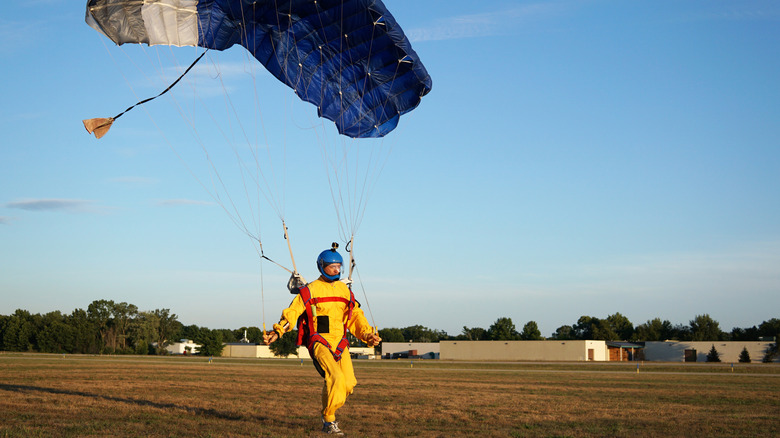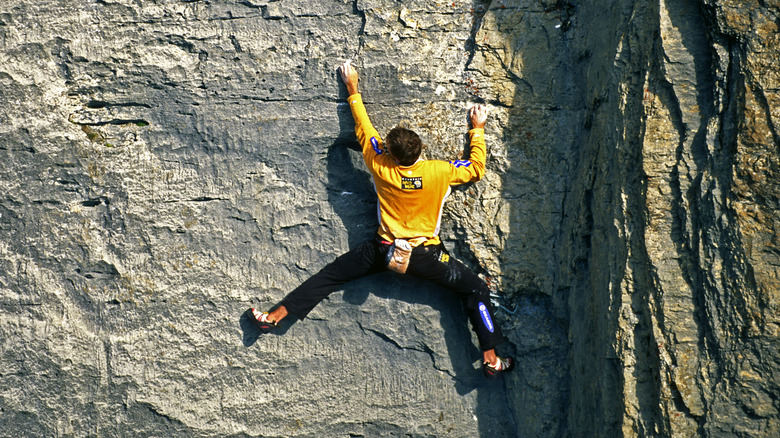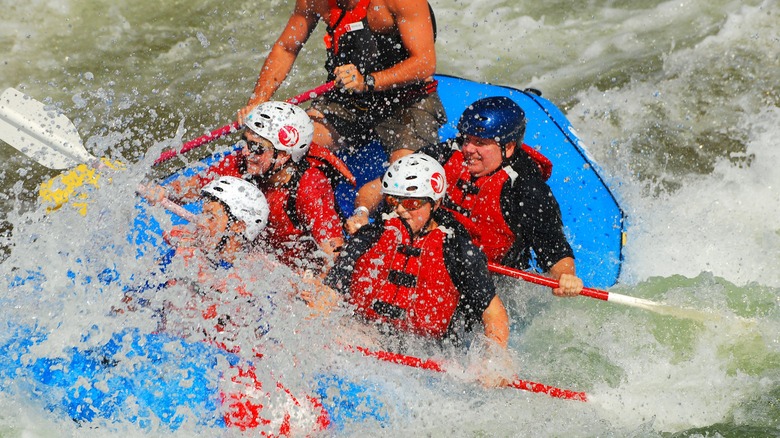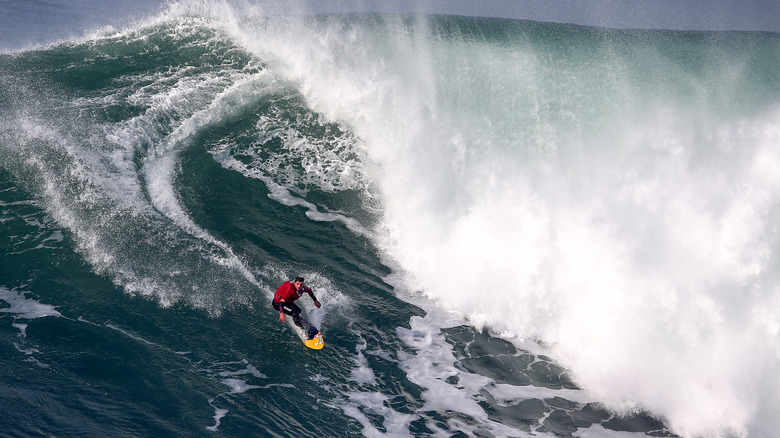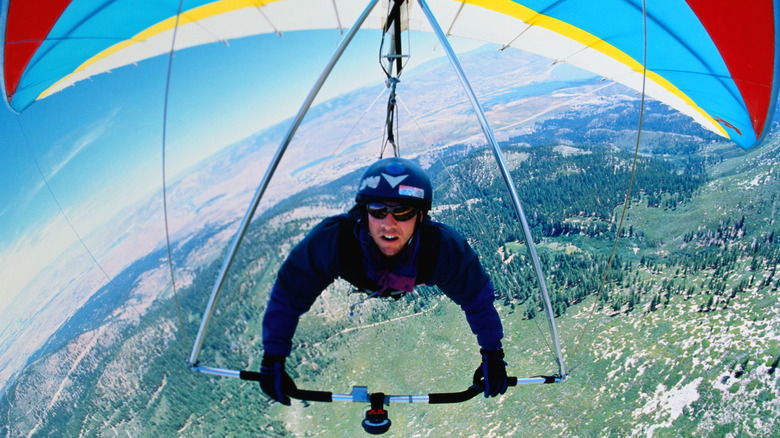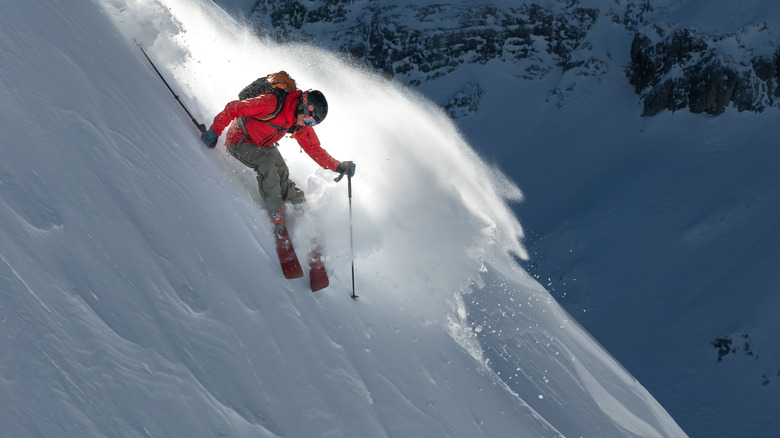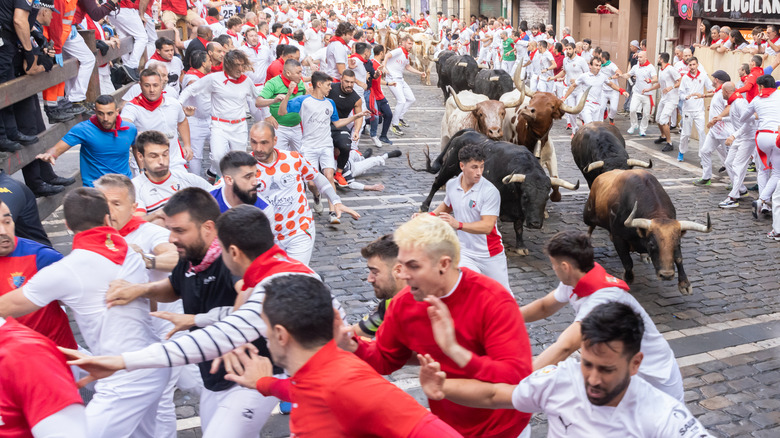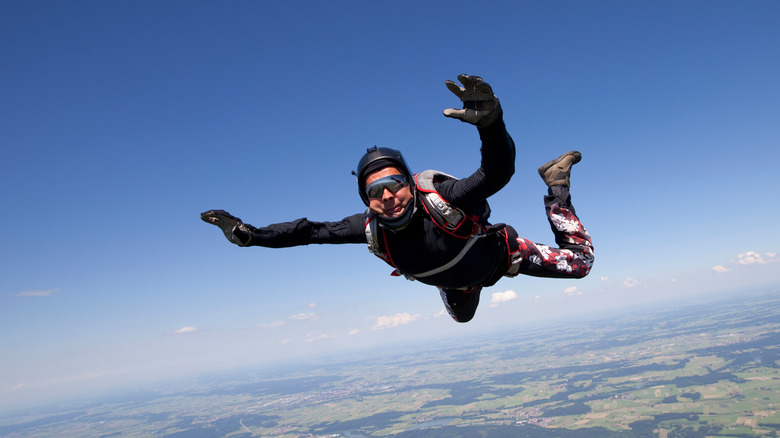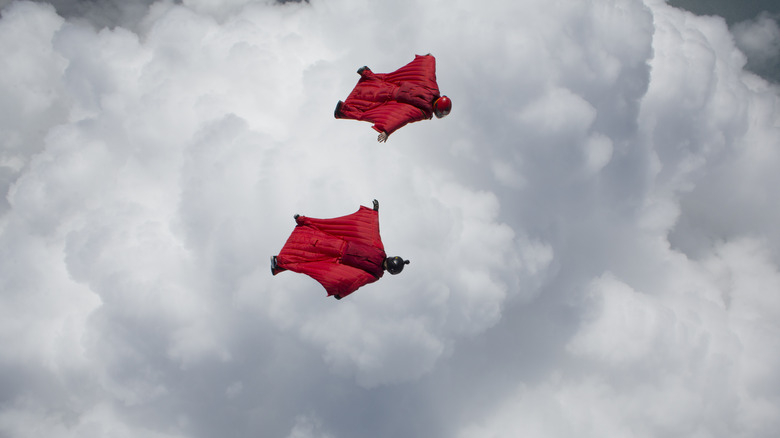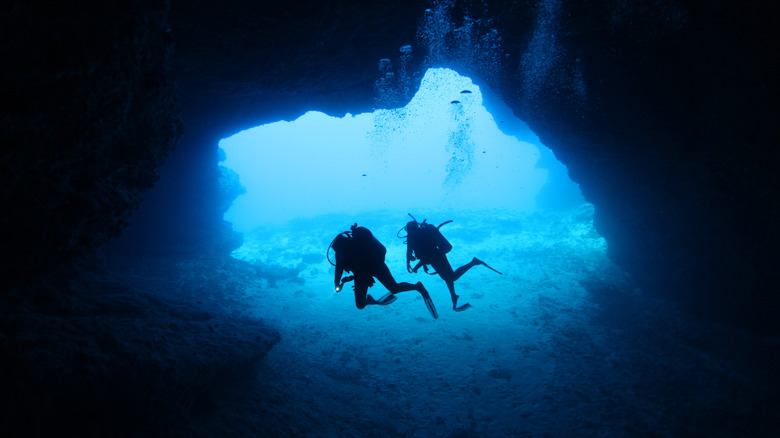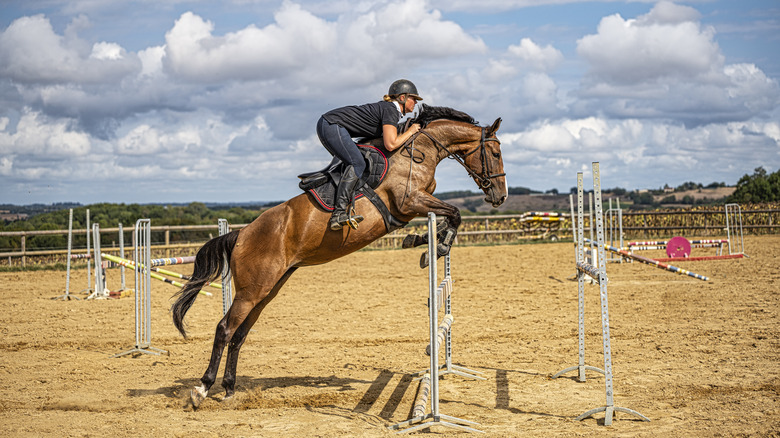Only True Thrillseekers Are Brave Enough To Try These Dangerous Outdoor Sports
Sports fill us with thrills. Think of the crack of the bat for a home run hit at a baseball game, or the Hail Mary pass that ends in a touchdown. What about the soccer ball flying through a goalkeeper's arms as he misses the save — and not to mention gloves being thrown down for a fight on the ice during a hockey game? Yes, sports are exciting — sometimes, a little too exciting.
Now, all of these are team sports, but there are plenty of solo outdoor sports you can participate in that are just as exciting. Hiking, kayaking, and the like are all excellent and affordable outdoor sports, but what about those sports that take things up a notch? Better yet, what about outdoor sports that are so thrilling they could be considered downright dangerous?
The sports that involve climbing to dizzying heights (or jumping off of them), or ones that involve considerable elemental dangers are the ones that only true thrillseekers are brave enough to tackle. There is no shortage of things that could go wrong with these 12 outdoor sports, which is why they are not for the faint of heart.
Mountain/free solo climbing
No sport has more risk of death associated with it than climbing, especially for those who try free solo climbing. According to Hard Climb, there are roughly 30 rock climbing deaths per year, 30% of which are from free solo accidents. Free solo climbing means there is no safety equipment and no belay partner to help in case of an emergency. It's just the climber, their skills, and their muscles. And while there are plenty of examples of free solo climbs going well, the danger involved is such that it should not be attempted unless you really know what you're doing.
The same is true for mountaineering. Climbing the world's most treacherous mountains is something that requires immense skill. Not only are you contending with making your body function at high altitudes, but you're also working with (or against) natural hazards like wind, snow, ledges, loose rocks, subzero temperatures, and a host of other dangers. This is one sport that could very easily kill you if you aren't careful.
Case in point is the number of people who die on the most iconic mountain in the world: Everest. According to The New York Times, nearly 20 people died trying to climb Everest in 2023, while the average number of deaths in a year hovers around 6.2 people –solid proof that climbing is an unpredictable sport where so much can quickly go wrong.
BASE jumping
An acronym for buildings, antenna, spans, and earth, BASE jumping involves jumping from a great height and not deploying your parachute until the last possible moment. Admittedly, jumping from a height, whether it's a skyscraper, cliffside, or a cellphone tower, is going to make your heart race with thrilling anticipation. The security of the parachute makes things a little safer, but there is still plenty that could go wrong.
For one, your parachute might not deploy. This is exceptionally rare, but it does occur, and hitting the ground could result in serious injury or death. Deployed parachutes could easily get twisted in extra windy conditions, resulting in them not being nearly as efficient as they would otherwise be. Then there's the fact that jumper error could cause the chute to deploy too late, which could cause the jumper to hit the ground very hard, potentially resulting in broken bones.
Now, Crawl Bars lists the fatality rate of BASE jumping at one in 2,317. This is a particularly dangerous statistic, but the fact remains that only 511 people have died BASE jumping since 1981, per the Base Fatality List. We don't want to make light of this fact, because BASE jumping still has the potential to be extremely dangerous, however fun it might be.
Whitewater rafting
There are varying degrees of thrill when it comes to whitewater rafting. A lot depends on whether or not you're going with a group or flying solo in your own kayak, and what class of rapids you will be going down. Class 1 rapids are fast-moving, but not so much so that they will be difficult to handle on your own. Rapid classes increase in number until class 6, which are extremely difficult, unpredictable waters. Most whitewater rafting occurs between classes 2 and 4, with the most thrilling rafting beginning at class 5.
Rapid water is unpredictable at any level, so you really need to know what you're doing if you're going to attempt this sport on your own. There are plenty of big mistakes people make when kayaking, but being able to resurface after your kayak capsizes is essential, as is having strong swimming abilities in case you are tossed from your boat. Reflexes are tremendously important on the water, as in higher-class rapids you'll need to be avoiding rocks and other obstructions.
Even if you are going with a group, you want to make sure that everyone knows what they're doing. Depending on the boat and the rapids, rowers could easily fall out and into the water, finding themselves soaring down the rapids. Lifejackets are a must for this outdoor sport that claims about 50 lives a year, according to Schnitzer Law Firm.
Big wave surfing
Big wave surfing is considered an art form by many. To see surfers ride enormous, cresting waves, threading the needle through the eye of the water, and coming out the other side before things come crashing down is nothing short of astounding. From the surfer's perspective, there must be nothing more breathtaking than being on the inside of that barrel, moving along as the water crests over your head. Balance is key when it comes to surfing, especially when safety is concerned.
Now, the ocean is harsh. There is no way anyone can go surfing on 30-foot swells and not feel small. As such, in some of the most dangerous surf spots in the world, you could easily find yourself on the wrong side of that water, being pummeled and battered by the crashing waves. For surfers who go down, the things they need to be most concerned with are being pulled back under by the current, or being caught in a rip current they cannot get out of. Drowning or hitting your head on rocks or coral is a very real possibility.
While surfing deaths are not overly common, they can still happen even to the most well-trained surfers. Even the most talented surfers, like Márcio Freire, have perished in the waves, which just goes to show how unpredictable and dangerous the ocean can truly be.
Cycling
When we say cycling, we're not talking about a bike ride on your local paved trail. We're not even, to a certain degree, talking about road cycling tours. Of course, there's the chance a car might come and hit a cyclist, but overall, standard road cycling is a relatively safe sport. However, things go to the next level when we talk about extreme cycling.
Think of an event like the Tour de France. This is road cycling at its most extreme, pushing riders to the very limit of what they're capable of in grueling races that climb up and down steep mountains — and in intense heat. Then there's mountain biking, which takes riders down mountainsides on incredibly steep, thin, and windy trails with plenty of obstacles and obstructions.
Now, the speed achievable on two wheels can be staggering. Cyclists need to have excellent control of their bikes because if they land wrong, or lean a little too far in one direction, they can end up off of the bike and into the weeds (or a cliff). A good fall from a bike in these extreme circumstances could leave you with broken limbs, paralyzed, and, if you're not wearing a helmet, some brain damage.
Hang gliding
Hang gliding is an extreme aerial sport that has the pilot literally hanging from a glider and flying through the air on wind power alone. Talented gliders can find air streams that will take them up to ridiculous heights, allowing them to look down upon the earth as if they were birds. And with no engine making noise, gliders have unprecedented access to the sky in ways most are never able to achieve. However, this thrilling sport is not without its dangers.
Most of the danger comes from inexperience. Rookie gliders carry the most risk for making life-threatening decisions. They could misjudge the air streams, weather, or even the gliding itself. However, this doesn't mean that pros aren't also at risk of things going wrong. Changes in weather, bad landings, and equipment malfunctions all play a role in how successful a glide can be.
That being said, according to Xola, there are roughly 3.5 hang-gliding deaths in a given year. This is not overly high, but it still brings into stark reality the fact that you are incredibly exposed to unpredictable elements when out hang gliding.
Extreme skiing
While many view downhill skiing as a luxury experience, the fact is that, for devotees of the sport, things can be extreme. Think of all those Red Bull videos showing the point of view of skiers as they descend down intensely steep cliff sides, or do incredibly intricate runs. Skiing can be extremely rewarding for those who know what they're doing. However, like with everything else on this list, it can also be very dangerous.
You really have to know what you're doing when it comes to extreme downhill skiing. Much like with hang gliding, rookies are most likely to make the kind of mistakes that could end up costing them their lives. Taking a jump wrong and getting buried in the snow could easily happen on a downhill descent. Also, losing control due to speed can cause skiers to crash into trees or other obstacles. Many skiers have died due to either being buried in the snow or crashing into trees.
According to Zinda Law Group, statistics taken over the last 10 years indicate that the fatality rate for skiing was 0.69 out of 1 million participants. Again, not a huge number, but it doesn't take away from the potential for danger. As with anything else, there is an element of unpredictability when it comes to skiing. One wrong move on the mountain could mean the difference between life and death.
The Running of the Bulls
Arguably the most dangerous run in the world, for one week a year, the streets of Pamplona, Spain are filled with runners wearing red bandanas. Bulls are released into the streets and proceed to chase down those runners. The goal is to stay in front of the bulls for a short period and run with them. This is the Running of the Bulls, and, according to Rick Steves, runners are considered close enough when you can feel the bull's breath on your pants.
Though this festival has taken place for over 800 years, very few people have died as a result of running with the bulls. However, there are very often scrapes, broken limbs, and head injuries from those who have fallen during this short, incredibly fast run. The most recent death at Pamplona occurred in 2009, when a man was gored to death by a bull on the fourth day of the festival, per Running of the Bulls.
While the danger comes mainly from the bulls, there is a decent amount that comes from the other participants. Falling in this run is very unlucky, as no one is likely to stop and help you, and you might get trampled by both people and bulls. Overall, it's got all the potential to be incredibly dangerous, and a contact sport to boot.
Skydiving
Skydiving is a popular sport that sees participants jumping out of planes at incredible heights and sailing toward the ground before pulling a parachute and gently landing back on the earth. To skydive is an act of faith and trust. The main trust is in the parachute — that it will deploy properly and slow you down enough to get you to the ground safely. It's also the hope that, if you're diving alongside a professional, they'll know what they're doing. However, there are obviously some potential dangers involved in skydiving.
Though fewer people are killed skydiving than hiking (think about that for a minute), the actual act of falling out of a fast plane and plummeting toward the ground is enough to fill anyone with dread. What if the parachute doesn't deploy? There are usually backup chutes in the event that occurs, but it is still a main fear people have. Parachute malfunctions do happen, and they almost always end in death or severe injury.
There are two types of dives when it comes to falling through the sky. First, there's the guided dive, where you are attached alongside a professional, and then there's free falling, where you go solo. Guided dives are usually recommended for those who are only planning on doing it once, whereas free falling is better suited for those adrenaline junkies who plan on regularly participating in the sport.
Wingsuit flying
Similar to skydiving and BASE jumping in that it offers thrills from high altitudes, wingsuit flying is probably the closest thing you will get to being an actual bird. Well, more like a flying squirrel, but you get the point. Wingsuits are designed to act like wings, spreading out between your arms and legs, catching the air, and allowing fliers to twist and maneuver. It's less cumbersome than hang gliding thanks to less equipment, but wingsuit flyers sacrifice altitude for maneuverability.
Gliding along solo, unaided by anyone else, is a feat that requires a tremendous amount of gut and skill. Most flyers will attach Go-Pros to their heads and engage in some pretty dramatic stunts. You almost want to hold your breath watching them, as it is truly astounding to see. Still, things can go wrong in a hurry.
Crashes have occurred from flyers going too low below a canopy, or crashing into mountainsides from ill-timed turns. The parachutes attached to the wingsuits can also get tangled and fail, causing issues and potential death. Overall, it's a little more controlled than other flying sports, but no less dangerous.
Cave diving
Scuba diving is a process by which swimmers are able to spend extended periods of time underwater thanks to weights and connections to oxygen tanks. Through a breathing apparatus, the diver is able to breathe, allowing for unprecedented access to oceanic depths. Exploring coral reefs, like the iconic Great Barrier Reef in Australia (just one of the adventurous destinations around the world that you should definitely add to your summer bucket list), and seeing various types of marine life are as thrilling to some as jumping out of a plane. However, there are times when scuba diving can get particularly dangerous — and no, it's not necessarily when you're swimming with sharks.
Cave diving is arguably the most dangerous type of underwater adventuring. Getting lost or stuck and running out of those vital oxygen supplies is only too real. According to a 30-year Diving and Hyperbaric Medicine study measuring cave diving deaths between 1985 and 2015, 161 divers had been killed doing cave dives. 67 were trained divers, while 87 were amateurs. Much like with hang gliding, it's the rookies that tend to make the most mistakes. That doesn't mean, however, that so-called pros are not at risk.
The main fear that comes with cave diving is the fact that it is incredibly easy to get lost. The closeness of everything causes sand to be kicked up, turning the water murky and all but unnavigable. Many divers have perished due to losing their way and running out of oxygen before finding a way out.
Horseback riding
Horseback riding has become something of a lost art, depending on what part of the world you live in. In the United States, barrel riding and other rodeo sports are incredibly popular in certain areas of the country. Still, there isn't a horse rider alive who will disagree with the fact that there's an inherent danger to riding these majestic animals.
The first among which is the fact that you are riding a living animal. Unlike a car, a horse has a mind of its own and will respond in kind to things or people that scare it. Accidents, including being kicked, trodden on, or thrown from the back of a horse have resulted in many injuries and fatalities over the years. In fact, the Brain Injury Association of Missouri states that about 1 out of every 10,000 horse riders die each year in a horse-related accident. Estimates indicate the actual number is around 710 deaths per year.
When it comes to horses, riders need to be careful and know what they are doing. Having control of the animal is the first step, but also knowing how to handle them off the saddle is incredibly important. Following the rules of the trade and understanding that horses are sensitive animals that will rear and strike if afraid will give riders a better appreciation for what these creatures are capable of.
